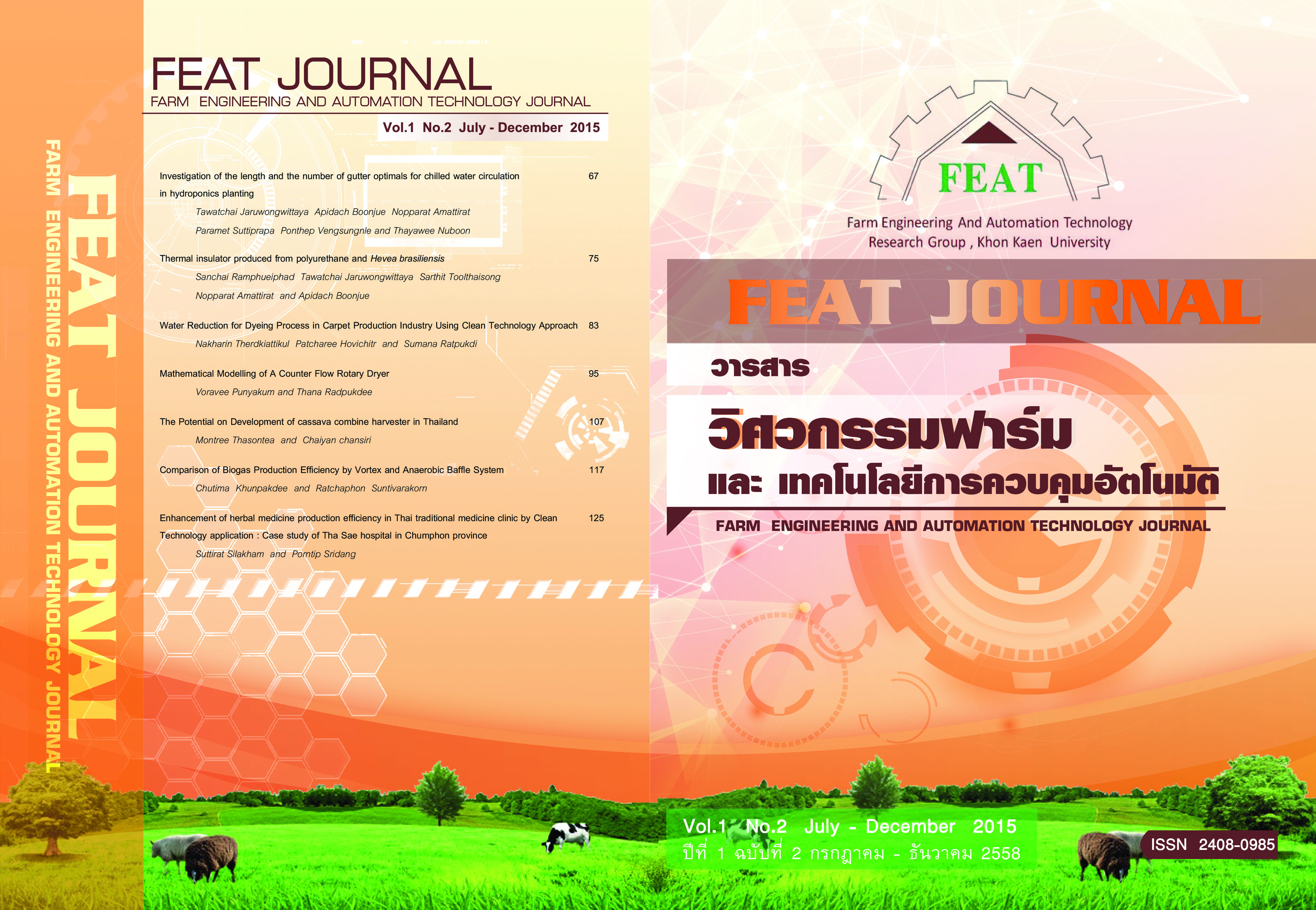การสร้างแบบจำลองทางคณิตศาสตร์ของระบบอบแห้งแบบหมุนชนิดไหลสวนทาง
Main Article Content
บทคัดย่อ
ในการควบคุมผ่านระบบควบคุมกำกับดูแลระยะไกล เพื่อทำให้ต้นทุนในการผลิตต่ำที่สุด ผู้ปฏิบัติงานจำเป็นต้องทราบค่าที่เหมาะสมในการสั่งการอุปกรณ์ทำงาน โดยในการหาค่าที่เหมาะสมสามารถหาได้จากวิธีพื้นที่ผิวตอบสนอง ซึ่งต้องใช้ผลการทดลองในกระบวนการจริงเป็นจำนวนมาก ซึ่งการทดลองอาจรบกวนกระบวนการผลิตและส่งผลต่อความเสียหายของอุปกรณ์ต่างๆในกระบวนการผลิตหากวางแผนการทดลองไม่ดีพอ เพื่อแก้ปัญหาความยุ่งยากดังกล่าว ผู้วิจัยจึงสร้างแบบจำลองทางคณิตศาสตร์มาใช้เป็นตัวแทนของกระบวนการผลิต ในที่นี้คือระบบอบแห้งแบบหมุนเพื่อที่จะสามารถนำไปวิเคราะห์ผลโดยวิธีพื้นผิวตอบสนอง แบบจำลองทางคณิตศาสตร์ได้รับการตรวจสอบโดยการเปรียบเทียบกับกระบวนการที่เกิดขึ้นจริงตามสภาพการดำเนินงาน ซึ่งแนวโน้มของการตอบสนองของแบบจำลองสามารถนำไปใช้แทนระบบจริงได้ โดยมีข้อผิดพลาดของอุณหภูมิของแข็ง, อุณหภูมิก๊าซร้อนและความชื้นของแข็งเท่ากับ 1.79%, 4.72% และ 3.54%, ตามลำดับ ซึ่งแบบจำลองดังกล่าวจะสามารถทำให้ได้ค่าตัวแปรที่ใช้ในระบบควบคุมกำกับดูแลระยะไกลต่อไป
Article Details
วารสารวิศวกรรมฟาร์มและเทคโนโลยีควบคุมอัตโนมัติ (FEAT Journal) มีกําหนดออกเป็นราย 6 เดือน คือ มกราคม - มิถุนายน และกรกฎาคม - ธันวาคม ของทุกปี จัดพิมพ์โดยกลุ่มวิจัยวิศวกรรมฟาร์มและเทคโนโลยีควบคุมอัตโนมัติ คณะวิศวกรรมศาสตร์มหาวิทยาลัยขอนแก่น เพื่อเป็นการส่งเสริมและเผยแพร่ความรู้ ผลงานทางวิชาการ งานวิจัยทางด้านวิศวกรรมศาสตร์และเทคโนโลยีพร้อมทั้งยังจัดส่ง เผยแพร่ตามสถาบันการศึกษาต่างๆ ในประเทศด้วย บทความที่ตีพิมพ์ลงในวารสาร FEAT ทุกบทความนั้นจะต้องผ่านความเห็นชอบจากผู้ทรงคุณวุฒิในสาขาที่เกี่ยวข้องและสงวนสิทธิ์ ตาม พ.ร.บ. ลิขสิทธิ์ พ.ศ. 2535
References
Ramazan, B. et al. (2011). A water pumping control system with a programmable logic controller (PLC) and industrial wireless modules for industrial plants—An experimental setup. ISA Transactions, 50(1), 321–328.
Figueiredo, J. et al. (2013). SCADA system with predictive controller applied to irrigation canals. Control Engineering Practice, 21, 870–886.
Boyer, S.A. (2009). SCADA: Supervisory Control and Data Acquisition. 4th ed. [n.p.]: International Society of Automation.
Salihbegovica, A., Marinkovia, V., Cicoa, Z., Karavdicb E. & Delica, N. (2009). Web based multilayered distributed SCADA/HMI system in refinery application. Computer Standard Interface, 31(3), 599-612.
Kyratsis, A., Bilalis, N. & Antoniadis, A. (2011). CAD-based simulations and design of experiments for determining thrust force in drilling operations. Computer-Aided Design, 43, 1879–1890.
Montgomery, D.C. (2001) Design and Analysis of Experiments. 5th ed. New York: John Wiley & Sons.
Gan, C.Y. & Latiff, A.A. (2011). Optimization of the solvent extraction of bioactive compounds from Parkia speciosa pod using response surface methodology. Food Chemistry, 124, 1277-1283.
Myers, R.H. and Montgomery. D.G. (2001) Response Surface Methodology. 2nd ed. .New York: John Wiley & Sons.
Arruda, E.B. (2008) Comparison of the performance of the roto-fluidized dryer and conventional rotary dryer. [n.p.].
Lobato, F.S. et al. (2008). Estimation of drying parameters in rotary dryers using differential evolution. Journal of Physics: Conference Series, 135, 012063.
Hamed Abbasfard, et al. (2013). Mathematical modeling and simulation of an industrial rotary dryer: A case study of ammonium nitrate plant. Powder Technology, 239, 499–505.

